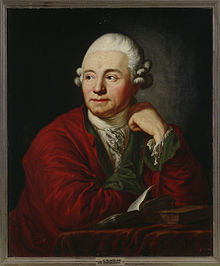Carl Wilhelm Muller
Carl Wilhelm Müller (born September 15, 1728 in Knauthain ; † February 28, 1801 in Leipzig ) was mayor of Leipzig several times from 1778 until his death. In this function he made outstanding contributions to the school system and the urban planning of Leipzig.

Life
Müller was born the son of a Knauthain local judge and later Leipzig court director. After attending the Princely School in Pforta , he studied law, history and philosophy at the University of Leipzig from 1741 to 1750 . He then worked as a lawyer at the Oberhofgericht in Leipzig. During this time he founded a literary discussion group, wrote poetry and edited a volume of poetry in collaboration with Christian Felix Weisse . From 1756 he published the magazine Brittische Bibliothek , which dealt with new publications in English literature.
His political activity began in 1759 when he became a member of the City Council of Leipzig. From 1771 Müller acted as city judge. In 1775 he was appointed head of the council library and in 1776 city architect. The Saxon government appointed him in 1778 to the Princely Privy Council of War. In the same year, Müller was elected mayor of Leipzig for the first time. The first term of office followed in the years 1778/79, 1781/82, 1784/85, 1786/87, 1788/89, 1790/91, 1792/93, 1794, 1795/96, 1797/98 and 1799/1800 more Terms of office.
During his time at the head of the Leipzig Council, numerous urban planning changes were made at his instigation, which still shape the cityscape of Leipzig today. From 1784 he pushed for the creation of parks in the area of the demolished city fortifications. In this way, under the direction of the city planning director Johann Carl Friedrich Dauthe (1746–1816), the Promenadenring, which corresponds to today's street ring around Leipzig city center , the Schwanenteich , the Schneckenberg and the Augustusplatz, was created . At Müller's suggestion, Dauthe built the first municipal concert hall above the old armory in 1781 ( Gewandhaus ) and in 1785–1796 the Nikolaikirche was redesigned in the classicism style. Müller also paid special attention to promoting the Leipzig school system. In 1783 he became head of the Nikolaischule . During his tenure, the first public elementary school was opened in 1792 with the Ratsfreischule and in 1796 the first citizen school.
Carl Wilhelm Müller was the first head of the Harmonie Society in Leipzig.
Honor
In the public consciousness, Müller is present today through the monument built in July 1819 at the instigation of Leipzig merchants in the promenade opposite the main train station . The monument, based on a design by Johann Friedrich August Tischbein (1750–1812) by the city planning director August Wilhelm Kanne (1783–1827), consists of a marble cuboid with a medallion with the portrait created by Johann Gottfried Schadow (1764–1850) on the south side Müller is appropriate.
In the Knauthain district of Leipzig, Müller's birthplace, popularly known as the Mayor Müller House, still stands today. The building, erected in 1723, was saved from deterioration at the end of 2008. In 2013 a café was opened there and an artist's studio moved in.
literature
- Franz Schnorr von Carolsfeld: Müller, Karl Wilhelm . In: Allgemeine Deutsche Biographie (ADB). Volume 22, Duncker & Humblot, Leipzig 1885, p. 642 f.
Web links
Individual evidence
| personal data | |
|---|---|
| SURNAME | Müller, Carl Wilhelm |
| BRIEF DESCRIPTION | Mayor of Leipzig |
| DATE OF BIRTH | September 15, 1728 |
| PLACE OF BIRTH | Knauthain |
| DATE OF DEATH | February 28, 1801 |
| Place of death | Leipzig |
